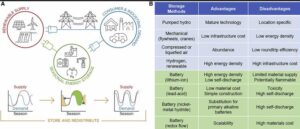
The prototype freeze-thaw battery in the laboratory is the size of a hockey puck
Preface. A 100% renewable grid can’t happen without long-term energy storage. Today that’s done with natural gas (with a little help from hydropower in the 10 states that have most of it). Meanwhile nuclear and coal chug along at a minimum baseline power since they’re damaged by ramping up or down faster than within a few hours. This is why scientists are trying to build batteries that can store energy seasonally.
The problem is, you can cram a utility scale battery with solar power in the summer — but long before you need the energy in the winter the battery will have discharged. Li et al (2022) point out that self-discharge rate ranges from approximately 3%–5% (Li-ion battery) to almost 30% (nickel [Ni] metal hydride battery) in the first month and point out other failings of Li-ion batteries, which face supply limits and geopolitical dangers if scaled up.
The information at this site is very hard to come by. Scientists and corporations want funding, and send out happy positive press releases. But the researchers often trash other technology in their field, such as revealing the issues li-ion batteries have for long-term storage and their very existence given Limits to Lithium. This article also has a nice chart of pros and cons of various energy storage technologies.
Li’s (2022) experimental battery that won’t discharge as fast as others. But it’s years — if ever — that it will grow from a hockey puck to a many-square mile sized battery able to store electricity seasonally (of course they don’t mention how large it would need to be, but ready my energy storage posts).
On top of that, if this battery doesn’t work out, you’ll never know — are you really going to remember to check on it 5 years from now? And if you do remember, the chances are that negative results won’t get published.
Also not mentioned is how much energy is required to freeze the salt battery, and then heat it to 180°C to get the electricity out? It’s too early in development to know how many times it can go through the freeze thaw cycle and how long it will last, how large to store a day of U.S. electricity and more. There are all sorts of other issues, such as that the only kind of utility scale battery with enough material on earth are Sodium Sulfur (read other energy storage posts here.)
I’m dubious molten salt will scale up since only 25% of concentrated solar power plants have molten salt to store excess electricity in. The billion dollar Crescent Dunes concentrated Solar Plant (CSP) can store 10 hours of electricity, or 0.001329 Twh a day with 70 million pounds of molten salt. You’d need 8265 more billion dollar Crescent Dunes to store just one day of U.S. 11.12 TWh of electricity. And multiply that by 30 since you need at least a month of storage to cope with seasonality.
My books explain why transportation and manufacturing can’t be electrified (or run on hydrogen and so on). So the grid and civilization as we know it will fail. But I suppose the longer the lights stay on the better, so I can post farewells to Facebook…
Alice Friedemann www.energyskeptic.com Author of Life After Fossil Fuels: A Reality Check on Alternative Energy; When Trucks Stop Running: Energy and the Future of Transportation”, Barriers to Making Algal Biofuels, & “Crunch! Whole Grain Artisan Chips and Crackers”. Women in ecology Podcasts: WGBH, Jore, Planet: Critical, Crazy Town, Collapse Chronicles, Derrick Jensen, Practical Prepping, Kunstler 253 &278, Peak Prosperity, Index of best energyskeptic posts
***
Casey T (2022) “Hibernating” Energy Storage Solves Seasonal Power Generation Problem. Cleantechnica
Li MM et al (2022) A freeze-thaw molten salt battery for seasonal storage. Cell reports Physical Science. https://doi.org/10.1016/j.xcrp.2022.100821

Even with the latest improvements, the best Li-ion batteries for bulk energy storage only offer a few hours of power generation before they need to be recharged. That fits many use short need situations, but not when a day or season of storage is needed.
Enter a Freeze Thaw Molten Salt Battery at PNNL that can store energy for months potentially and lie idle for one to 8 weeks and not self-discharge as much as li-ion and others do. Just heat to 180 C, cool to room temperature to lock in energy, and reheat to get the energy back. These will use molten salt, which is the same way Concentrating Solar Power systems store excess energy. Although since most areas of the U.S. can get cold and dip below freezing, that would require even more energy to reheat the battery to get energy storage out, and there will also be round-trip losses.

One Response to Hibernating freeze-thaw molten salt batteries for seasonal energy storage